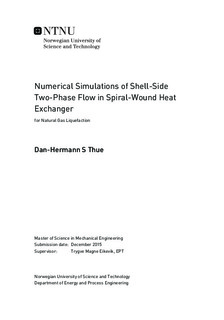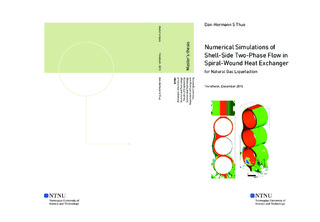| dc.description.abstract | Heat transfer coefficients and pressure drop of evaporating heat exchangers such as the spiral wound heat exchanger depend on the distribution of the refrigerant fluid. However little open research is available in the study of Spiral wound heat exchangers (SWHE) flow for LNG liquefaction. Only a handful of producers have the most experience in the production of such heat exchangers. The number of studies on two-phase liquid-gas flows on shell side of heat exchangers are still limited compared to in tube two phase flows. Most studies already done have focused on air water mixtures and some CFC refrigerants, which are now banned in most countries. In addition, the most commonly covered mass flows are in a larger range than typically used in refrigeration systems, in which typical systems use a range of 5 to 60 kg/m2s.
A method of flow patterns study of two phase liquid-gas flow over a horizontal tube bundle has been developed. The tube bundle is comparable, although simplified, to the geometry in the spiral wound heat exchanger tested in the laboratory at Shanghai Jiao Tong University. Liquid-vapor two-phase shell side flow phenomena is simulated in 3D using ANSYS ICEM for meshing, Fluent for calculations and CFD-Post data accumulation software. Flow patterns and data are observed mainly at vapor qualities between 0.1 and 0.7 and mass flux range of 10 50 kg/m2s.
A method for measuring void fractions is established and then compared according to established theory. The Feenstra-Weaver-Judd method is so far the most advanced prediction model and the best fitting for the largest part of the range studied. The higher the mass flux and vapor quality the better the prediction is comparted to the model.
A close relationship between void fraction, and transition to new flow patterns was discovered. Especially in differences between spray flow and falling film flow.
The measured void fractions were found to vary when increasing the vertical distance of the tubes. From 1mm to 4mm case at a constant mass flux the void fractions were consistently higher and the transition to a new flow regime thus came faster and at a lower vapor quality.
The model is compared against the findings of the laboratory test at SJTU with propane, and the correlation of flow patterns fit well with the simulations.
The CFD models flow pattern results were compared to results from lab experiments. The geometry in the CFD model is simplified compared to the SWHE model in the lab. Despite this there was good agreement with the flow pattern findings between simulation and lab results.
Different fluids and geometries can be tested using this model. In this report, Propane was used as refrigerant fluid and material properties were obtained using REFPROP software at saturation point for 0.3 MPa. | |

